
|
Cleaning is one of the most important measures for maintaining and ensuring a long-lasting efficiency of drain and sewer systems. Cleaning measures can either be implemented proactively or reactively. This third volume of the second edition of "Rehabilitation and Maintenance of Drains and Sewers" focuses on the development of a cleaning plan, the cleaning of drains and sewers, catch basins, large profiles, and pressure lines. |
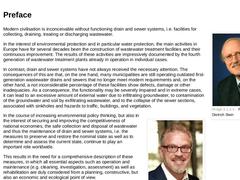
|
(Image: Prof. Dr.-Ing. Dietrich Stein)Modern civilisation is inconceivable without functioning drain and sewer systems, i.e. facilities for collecting, draining, treating or discharging wastewater. In the interest of environmental protection and in particular water protection, the main activities in Europe have for several decades been the construction of wastewater treatment facilities and their continuous improvement. The results of these activities … |

|
|
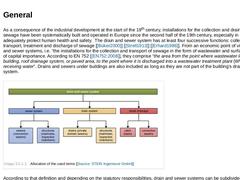
|
As a consequence of the industrial development at the start of the 19th century, installations for the collection and drainage of sewage have been systematically built and operated in Europe since the second half of the 19th century, especially in order to adequately protect human health and safety. The drain and sewer system has at least four successive functions: collection, transport, treatment and discharge of sewage [ [Büker2000]] [ [Strell1913]] [ [… |
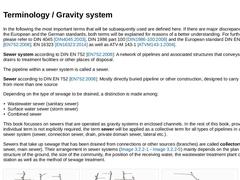
|
In the following the most important terms that will be subsequently used are defined here. If there are major discrepancies between the European and the German standards, both terms will be explained for reasons of a better understanding. For further information please refer to DIN 4045 [DIN4045:2003], DIN 1986 part 100 [DIN1986-100:2008] and the European standard DIN EN 752 [EN752:2008]; EN 16323 [EN16323:2014] as well as ATV-M 143-1 [ATVM143-1:… |
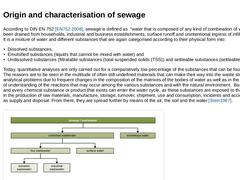
|
According to DIN EN 752 [EN752:2008], sewage is defined as “water that is composed of any kind of combination of water that has been drained from households, industrial and business establishments, surface runoff and unintentional ingress of infiltration water”. It is a mixture of water and different substances that are again categorised according to their physical form into: -
Dissolved substances,
-
Emulsified substances (liquids that cannot be mixed …
|
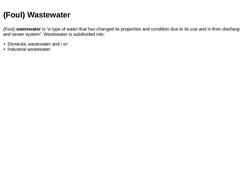
|
(Foul) wastewater is “a type of water that has changed its properties and condition due to its use and is then discharged into a drain and sewer system”. Wastewater is subdivided into: -
Domestic wastewater and / or
-
Industrial wastewater
|

|
Domestic wastewater is “wastewater discharged from kitchens, laundry rooms, lavatories, bathrooms, toilets and similar facilities” [EN752:2008]. The main sources of the substances that can be found in domestic wastewater are human excrement and water used for washing and cleaning [Stein1987]. Domestic wastewater also includes sewage from small trade premises (e.g. a petrol station, doctor’s surgery, wholesale or retail merchant, workshop and/or laundry) … |

|
Industrial wastewater is the “runoff of industrial and commercial wastewater”. DIN EN 752 [EN752:2008] defines industrial/commercial wastewater as “discharge resulting from any industrial or commercial activity”. The composition of the industrial wastewater depends on the economic structure of the municipality [Stein1987] [Stein1989]. General guidelines with regard to the most important characteristics of substances that may still be considered safe … |
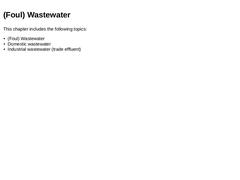
|
|
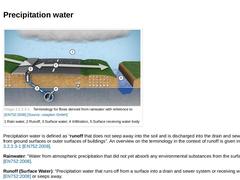
|
(Image: Terminology for flows derived from rainwater with reference to EN 752) Precipitation water is defined as “runoff that does not seep away into the soil and is discharged into the drain and sewer system from ground surfaces or outer surfaces of buildings”. An overview on the terminology in the context of runoff is given in Image 1‑12 [EN752:2008]. Rainwater: “Water from atmospheric precipitation that did not yet absorb any environmental substances … |

|
Infiltration water is “an unwanted ingress of water into a drain and sewer system” [EN752:2008]. The category of infiltration water includes infiltrated groundwater, water that is discharged via faulty connections without permission (e.g. wastewater, seepage water and groundwater that enters a surface water sewer from building and site drainage systems, and discharge of smaller rivulets into the sewer system). The quantity of infiltration water varies … |

|
|

|
Sewers with widely varying cross sections and dimensions have been used since the beginning of modern sewage technology and some are still in use in their original form to this day. (Image: Standardised sewers cross sections with geometrical values at full filling according to DIN 4263 (06.2011) (DIN 4263)) The most important cross sectional shapes, which are also called sewer profiles, are the circular, the standard ovoid and the standard arch cross … |

|
According to DIN EN 1610 [ [DINEN1610:1997]], depth of cover (formerly also called depth position) is defined as “the vertical distance from the top of the pipe barrel to the surface." Considering the minimum required gradient of 1.0 % to 2.0 % for the laterals and pipes that are installed below all other supply lines in the pavement and the installation depth of the cellar inlets inclusive of the drain traps, the following guide values for the individual … |
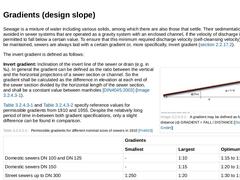
|
Sewage is a mixture of water including various solids, among which there are also those that settle. Their sedimentation can be avoided in sewer systems that are operated as a gravity system with an enclosed channel, if the velocity of discharge is not permitted to fall below a certain value. To ensure that this minimum required discharge velocity (self-cleansing velocity) can always be maintained, sewers are always laid with a certain gradient or, … |

|
The laying of sewers has been and still is carried out either by means of open cut or trenchless methods of construction. Depending on the chosen method of construction, there are different pipe-soil-systems with different external loads acting on the sewer. These can decisively influence the type and extent of damage as well as the chosen rehabilitation method. This holds true especially for injection processes and pipe replacement processes, for … |
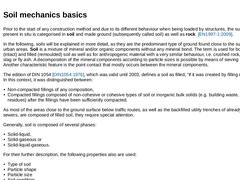
|
Prior to the start of any construction method and due to its different behaviour when being loaded by structures, the subsoil that is present in situ is categorised in soil and made ground (subsequently called soil) as well as rock [EN1997-1:2009]. In the following, soils will be explained in more detail, as they are the predominant type of ground found close to the surface in the urban areas. Soil is a mixture of mineral and/or organic components … |
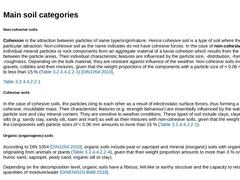
|
Non-cohesive soils Cohesion is the attraction between particles of same type/origin/nature. Hence cohesive soil is a type of soil where there is an inter-particular attraction. Non-cohesive soil as the name indicates do not have cohesive forces. In the case of non-cohesive soils, the individual mineral particles or rock components form an aggregate material of a loose cohesion which results from the friction between the particle areas. Their individual … |

|
The particle shape of fine soils solely depends on the type of mineral. Generally, quartz, lime and dolomite are cubic, clay minerals flat and halloysite (compound silicate) oblong. For coarse soils, the particle shape and roughness depends on the type of rock and its transport and weathering history. A longer transport distance leads to rounded particle contours and smooth particles, whereas weathering effects can increase the particle roughness … |
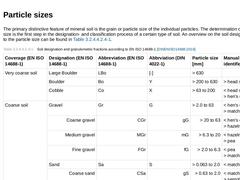
|
The primary distinctive feature of mineral soil is the grain or particle size of the individual particles. The determination of the particle size is the first step in the designation- and classification process of a certain type of soil. An overview on the soil designation subject to the particle size can be found in Table 1‑15. (Table: Soil designation and granulometric fractions according to EN ISO 14688-1 (06.2011)) The so-called granulometric fraction |

|
According to DIN EN ISO 14688-1 [DINENISO14688:2018], the soil condition is defined by the degree of compaction for coarse soils and by the consistency for fine soils. Bedding density By means of the bedding density it is described how the individual particles of coarse soils have arranged or placed next to each other. With this knowledge direct conclusions can be drawn on the soil strength, the additional compaction or displacement capability or the … |
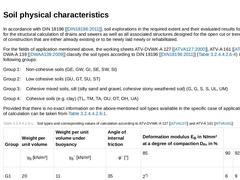
|
In accordance with DIN 18196 [ [DIN18196:2011]], soil explorations in the required extent and their evaluated results form the basis for the structural calculation of drains and sewers as well as all associated structures designed for the open cut or trenchless method of construction that are either already existing or to be newly laid newly or rehabilitated. For the fields of application mentioned above, the working sheets ATV-DVWK-A 127 [ [ATVA127:… |

|
|

|
Hydrogeology is the study of the behaviour of water in the ground regardless of its state of aggregation – solid (frozen), liquid (groundwater) or gaseous. Hydrogeology also captures the interactions between groundwater and surface water (receiving water and bank filtrate). Normally, water traverses the underground within the cavities of the soils, the cleavages and joints of rocks and the cave systems of the karst regions [ [UBA93]]. In the given … |